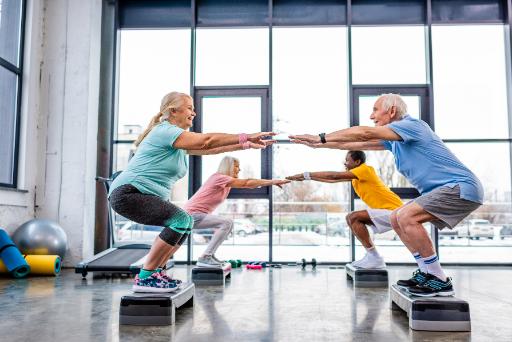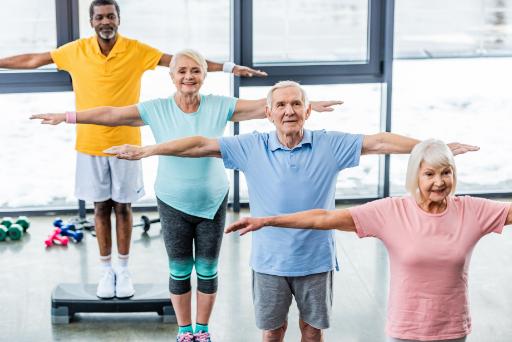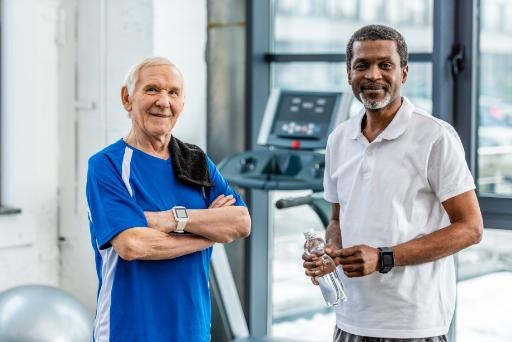As you get older, you may notice changes in your body and abilities. You may not be able to do the same things you used to, or you may experience aches and pains. But that doesn’t mean you must give up on your senior fitness goals. In fact, staying physically active is one of the best ways to maintain your health and quality of life as you age.
Regular exercise can help you prevent or manage chronic conditions such as heart disease, diabetes, arthritis, and dementia. It can also improve your mood, memory, balance, coordination, and bone density. And it can make you feel more confident, energetic, and happy.
But how much exercise do you need as a senior? And what kind of exercise should you do? In this blog, we will answer these questions and provide some tips and resources to help you start or maintain a senior fitness routine.
How Often Should Seniors Exercise ?
The answer to this question depends on your current health status, fitness level, and personal preferences. However, a general guideline is to follow the recommendations from the World Health Organization (WHO), which suggest that older adults should do at least 150 minutes of moderate-intensity aerobic exercise, 75 minutes of vigorous-intensity aerobic exercise, or a combination of both per week.

Aerobic exercise, also known as cardio, is any activity that raises your heart rate and makes you breathe faster. Aerobic exercise includes walking, jogging, cycling, swimming, dancing, and playing sports. Aerobic exercise can improve your cardiovascular health, endurance, and metabolism.
In addition to aerobic exercise, the WHO also recommends that older adults should do muscle-strengthening activities involving major muscle groups at least twice a week. Muscle-strengthening activities, also known as resistance training, are any exercises that make your muscles work harder than usual. Examples of muscle-strengthening activities include lifting weights, using resistance bands, doing bodyweight exercises, and doing yoga or pilates. Muscle-strengthening activities can improve your muscle mass, strength, power, and function.
Furthermore, the WHO advises that older adults with poor mobility should do physical activities three or more days per week to enhance balance and prevent falls. Balance exercises are any activities that challenge your ability to keep your body stable and upright. Examples of balance exercises include standing on one leg, walking heel-to-toe, doing tai chi, or using a stability ball. Balance exercises can improve your posture, coordination, and reaction time.
How Much Exercise for Seniors ?
The amount of exercise you need as a senior depends on your goals, abilities, and limitations. There is no one-size-fits-all formula for senior fitness. However, a general principle is to start low and go slow. That means you should begin with a quiet intensity and duration and gradually increase them as you get more comfortable and confident.

A good way to measure the intensity of your exercise is to use the Rating of Perceived Exertion (RPE) scale, which ranges from 0 to 10, where 0 is no effort, and 10 is maximal effort. The RPE scale is based on how you feel during the exercise, not how fast or far you go. A moderate-intensity exercise makes you feel somewhat hard, or around 5 or 6 on the RPE scale. A vigorous-intensity exercise is one that makes you feel very hard, or around 7 or 8 on the RPE scale.
Another way to measure the intensity of your exercise is to use the Talk Test, which is based on how easy or difficult it is for you to talk during the exercise. A moderate-intensity exercise is one that allows you to talk but not sing. A vigorous-intensity exercise is one that makes you breathe too hard to say more than a few words.
The duration of your exercise is how long you do it. The WHO recommends that you do at least 10 minutes of continuous exercise at a time and accumulate at least 150 minutes of moderate-intensity or 75 minutes of vigorous-intensity exercise per week. However, you can also break up your exercise into shorter bouts, such as 5 minutes or more, as long as they add up to the recommended amount. You can also mix and match different types and intensities of exercise as long as you meet the minimum requirements.
How Much Exercise per Week for Seniors ?
The amount of exercise per week for seniors is the same as the amount of exercise per week for adults of any age, which is at least 150 minutes of moderate-intensity or 75 minutes of vigorous-intensity aerobic exercise, plus muscle-strengthening activities at least twice a week, and balance exercises if needed. However, you can also do more than the minimum amount as long as you do not exceed your physical capacity or cause any harm to yourself.

The benefits of exercise are dose-dependent, which means that the more you do, the more you gain. However, the benefits also plateau at a certain point, which means there is a limit to how much you can improve. Therefore, you should aim for an optimal dose of exercise, which is the amount that gives you the most benefits with the least risks.
According to a study by the Harvard School of Public Health, the optimal dose of exercise for seniors is about 300 minutes of moderate-intensity or 150 minutes of vigorous-intensity aerobic exercise per week, plus muscle-strengthening activities at least twice a week. This amount of exercise can reduce the risk of premature death by 39% compared to no exercise. However, doing more than this amount does not provide any additional benefits and may even increase the risk of injury or overtraining.
Therefore, you should aim for the optimal dose of exercise per week, but not more than that. You should also listen to your body and adjust your exercise accordingly. You should stop or reduce your exercise if you feel pain, discomfort, fatigue, or any other signs of distress. If you have any medical conditions or concerns, you should consult your doctor before starting or changing your exercise routine.
Should Seniors Exercise Every Day ?
The answer to this question depends on your personal preference, schedule, and goals. However, a general rule of thumb is to exercise at least three times a week, preferably five times a week, for optimal health and fitness benefits. Exercising every day is unnecessary and may even be counterproductive, as your body needs time to rest and recover between workouts.
However, exercising every day does not mean doing the same type or intensity every day. You can vary your exercise routine by alternating between different kinds of exercise, such as aerobic, muscle-strengthening, and balance exercises, and by varying the intensity, duration, and frequency of your exercise sessions. For example, you can do a moderate-intensity aerobic exercise for 30 minutes on Monday, Wednesday, and Friday, and a muscle-strengthening exercise for 20 minutes on Tuesday and Thursday, and a balance exercise for 10 minutes on Saturday and Sunday. This way, you can exercise every day but still give your body enough variety and recovery time.

Another option is to do a low-intensity exercise every day, such as walking, stretching, or gardening, and a high-intensity exercise a few times a week, such as jogging, cycling, or swimming. This way, you can maintain your daily physical activity but still challenge your body and improve your senior fitness level.
The bottom line is that you should exercise as often as possible and as much as you enjoy, but not more than you need or can handle. It would help if you also balance your exercise with other aspects of your life, such as your work, family, hobbies, and social activities. Remember, exercise is not a chore but a choice. It is something you do for yourself, not for anyone else. It is a way to enhance your health, happiness, and well-being, not to compromise them.
Conclusion
Senior fitness is not a myth but a reality. You can stay healthy and active as you age as long as you follow some simple guidelines and tips. It would help if you exercised regularly, but not excessively. It would help if you did various exercises, but not the same ones every day. It would help if you challenged yourself but did not overdo it. It would help if you enjoyed yourself but did not neglect yourself.
Exercise is good not only for your body but also for your mind and soul. It can help you prevent or manage chronic diseases, improve your mood and memory, boost your confidence and energy, and make you feel more alive and youthful. It can also help you connect with other people, share your experiences, and have fun.
So, what are you waiting for? Start or continue your senior fitness journey today. You are never too old to exercise, and you are never too old to benefit from it. You have nothing to lose and everything to gain. You are not just a senior; you are a super senior.







